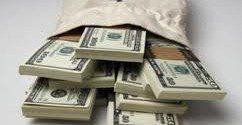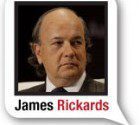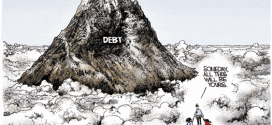There are a number of U.S. error coins and die varieties in circulation today worth from $30 to $35,000 because they have small distinguishing characteristics that make them rare and valuable. This article will tell you which of your pocket change coins might be worth a large premium over face value, and why. Words: 1076
So says Susan Headley (www.about.com) in edited excerpts from an article* which Lorimer Wilson, editor of www.munKNEE.com (It’s all about Money!), has further edited ([ ]), abridged (…) and reformatted below for the sake of clarity and brevity to ensure a fast and easy read. Please note that this paragraph must be included in any article re-posting to avoid copyright infringement.
Headley goes on to say:
Tip: Be sure to do your hunting with at least a 6x power magnifier so you don’t miss anything!
1. 1969-S Lincoln Cent With a Doubled Die Obverse
This coin is exceedingly rare. The early specimens were confiscated by the Secret Service until the U.S. Mint admitted they were genuine. Counterfeits abound, but usually have the wrong mint mark.
How to Detect: Look for clear doubling of the entire obverse (“heads” side) except for the mint mark. If the mint mark is doubled, it is probably a case of strike doubling, rather than a doubled die, which isn’t worth much. (Mint marks were punched in the dies separately in 1969, after the doubled die itself had already been made.) Note: Click on the image above to greatly enlarge it and see details.
Approximate Value: Around $35,000 or more in EF-40 or so.
2. 1970-S Small Date Lincoln Cent With a Doubled Die Obverse
As with virtually all true doubled die varieties, only one side of the coin shows doubling. If both sides exhibit doubling, the coin probably exhibits strike doubling instead, and is worth little.
How to Detect: The rarer Small Date variety is most easily distinguished from the common type by the weakness of LIBERTY. The Doubled Die Obverse is best demonstrated by doubling in LIB and IN GOD WE TRUST.
Approximate Value: Around $3,000 in EF-40 or so.
3. 1972 Lincoln Cent With a Doubled Die Obverse
The 1972 (no mint mark) Lincoln Cent doubled die variety shows strong doubling on all elements. The “Cherrypicker’s Guide to Rare Die Varieties”, which was an important source for this article, suggests using a “die marker” to help verify your finds. A die marker is a gouge or crack that identifies a particular die.
How to Detect: Clear doubling of all obverse elements; look for a tiny gouge near the edge above the D in UNITED as a die marker.
Approximate Value: About $500 in EF-40 or so.
4. 2004-D Wisconsin State Quarter With an Extra Leaf
Variety experts disagree about the cause and long-term value of this type, but I’ve included in the list because it is very findable in pocket change and worth hundreds of dollars right now.
How to Detect: There is some defect on the die that makes it appear as if there’s an extra leaf on the lower left-hand side of the ear of corn on the reverse. The leaf is very clear. Known in two varieties, the High Leaf and the Low Leaf type.
Approximate Value: $200-$300 in MS-60 or so.
5. 1999 Wide “AM” Reverse Lincoln Cent
This variety is known for 3 dates, 1998, 1999, and 2000, with 1999 being by far the rarest. The mint erroneously used a proof die to strike normal circulation coins.
How to Detect: The AM in AMERICA on the reverse is clearly separated in the Wide variety. In the normal variety for these dates, the letters AM are very close or touching.
Approximate Value: $5 to $25 in circulated condition, $75 to $600 in MS-63 or better depending on color. 1999 brings the highest prices, with 2000 being the second best year.
6. 1982 No Mint Mark Roosevelt Dime
At the point in time that these coins were made, the dies sent to the individual branch mints would be punched with the proper mint mark letter for that branch. This variety is believed to be caused because one or more non-punched dies were used to make coins. (The letter P was being used for Philadelphia on dimes at this time.)
How to Detect: The 1982 dime is missing a mint mark.
Approximate Value: About $30 to $50 in AU-50, more for higher grades.
7. Presidential Dollar Edge Lettering Errors
Ever since the first Presidential Dollar (the Washington Dollar issued in 2007) there have been errors associated with the lettering on the edge of these coins. In some cases it is missing entirely. In others, the edge lettering has been placed there multiple times.
How to Detect: Look at the edge. The inscription should appear fully incused all around the circumference of the coin. Missing or doubled inscriptions are rare and valuable.
Approximate Value: $50 to $3,000, depending on the President.
8. 1995 Doubled Die Obverse Lincoln Cent
This doubled die variety generated a lot of mainstream interest when it was featured as a cover story in USA Today. Specimens are still being found in circulation all the time!
How to Detect: Clear doubling in LIBERTY and IN GOD WE TRUST.
Approximate Value: About $20 to $50 in Uncirculated condition.
9. Certain Uncirculated State Quarters
As the economy has worsened, people who have been hoarding rolls of State Quarters have been spending them into circulation. If you can put together whole rolls Uncirculated quarters of certain in-demand states, you can get as much as $50 per roll for them.
How to Detect: Demand changes from time-to-time based on major coin dealer promotions. Currently, look for Georgia, Connecticut, Tennessee, and Illinois. Quarters must be Uncirculated!
Approximate Value: $20 to $52 per roll for strictly Uncirculated rolls of certain states.
10. Silver Half Dollars
Most people think that the silver in U.S. coins ended in 1964, but this isn’t true. The Half Dollar coin had silver in it until 1970. Many people spend the Half Dollars from 1965 to 1970, or sell them in rolls of halves they take to the bank, not realizing they are 40% silver.
How to Detect: If the Half Dollar is dated 1964 or earlier, it is 90% silver. Halves dated from 1965 to 1970 are 40% silver. You might also find silver Proof Half Dollars, which are 90% silver and dated to current. Silver Proof Halves have very shiny, mirror-like surfaces and there is no copper color when you view the edge.
Approximate Value: Value is based on silver spot price.
*http://coins.about.com/od/uscoins/tp/errorvarieties.htm
Related Article:
1. Can I Invest in Physical Gold & Silver in My IRA?
I have an IRA. How can I invest in gold and silver? It is quite easy! Yes, I am talking about actual physical gold and silver, not “paper” gold, or certificates, or paper promises. Words: 621
2. There’s a Dirty Little Secret to Cleaning Bullion Coins – Here’s How
Improper cleaning results in the loss of a small amount of metal from the surface of the coin. Repeated cleaning can actually lower the grade of a coin by removing too much metal. To learn the answer as to what is the best way to go about storing and cleaning your gold and silver coins read on. Words: 417
3. Beware The Dangers of Buying Gold Coins
At first glance, buying gold may seem a simple, straight forward process. However, there are dangers, such as falling for a telemarketer’s line that his coins are “non-confiscatable” and somehow have more value because you bought them from him. Basic bullion is the way to go when investing in gold. Words: 788
4. Eagles, Buffaloes & Maple Leafs: Gold Bullion Coins of U.S. & Canada
I think we all would agree that owning a 10 kg bar of gold would be nice but that it is probably out of the question at the current cost of over $500,000! I had the pleasure of caressing such a bar recently and being surprised at just how heavy (22.045855 lbs.) it was for such a small object. Below I describe the gold coins of Canada and the United States. Words: 870
 munKNEE.com Your Key to Making Money
munKNEE.com Your Key to Making Money



